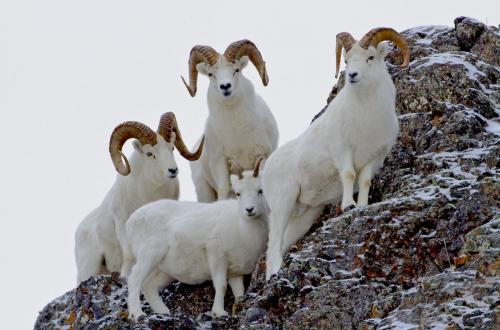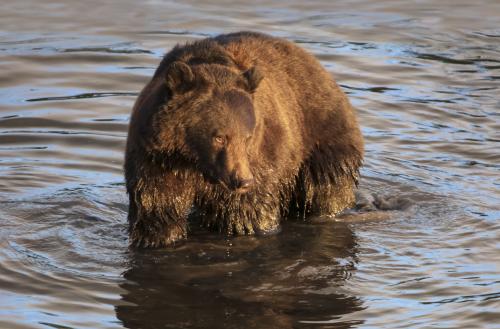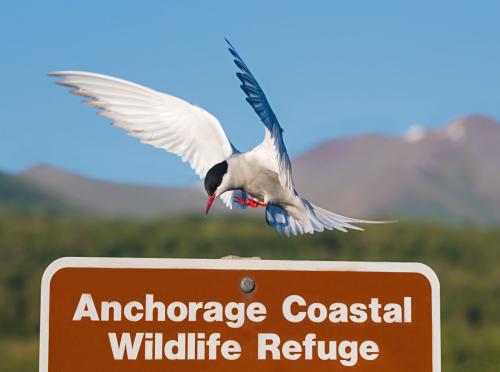The Anchorage area can be a winter wonderland for wildlife viewing and photography. Auroras may light up the night sky, but local wildlife provide the daytime show, and this season’s regular supply of fresh snow keeps refreshing the beauty of the city and its surroundings!
Moose
In the winter, wildlife will be where the food is, which can make finding them a little more predictable. Moose will avoid any deep snow, which can concentrate them along the roadsides. The older, smarter moose avoid active traffic and stay in the quieter parts of town such as Kincaid and Russian Jack parks, Northern Lights Blvd near the airport, and any groomed ski and multiuse trails. They survive the winter eating bark and leaving behind those classic wooden moose droppings. Surviving on a lean, bark diet can make them a little grumpy, so keep your distance and give them the right-of-way. The moose rutting season (when the big bulls fight over the females) is mostly over by mid-November, but younger bulls seem always willing to play fight. Right after the rut, the big bulls shed their antlers, by early to mid- December, with the smaller bulls hanging onto them into January. At this point, most cow moose are already pregnant, with their bellies growing visibly larger as spring approaches.
Dall Sheep
November and into December is a good time to catch Dall sheep rams head butting over the ladies (ewes). The best odds of viewing sheep are along the Seward Highway, from Anchorage mileposts 12 to 30. Driving can be hazardous along this stretch in the winter, so don’t brake to get a better look! Its better to pull over and stop in one of the many plowed pull-outs and get out your binoculars. Zooming in with your cell phone or camera’s long lens may be needed to safely take good photos. If willing to venture further out on foot, Dall sheep can also be viewed in Chugach State Park using common access points such as the Glen Alps parking lot. In heavy snow years, snow machines may have limited access.

Mountain Goats
Venture further south along the Seward Highway to the Whittier/Portage Access Road or go north along the Glenn Highway toward Palmer and those white spots seen high on the mountainsides are more often mountain goats, rather than Dall sheep. Their fur is longer and more off-white to pale yellow and you won’t see the big, curved horns like on the Dall sheep rams. In the winter, mountain goats will venture lower in the mountains as the snow and ice cover the alpine plants they eat. They will also come down among the spruce trees to take shelter from the winter storms. Yet, binoculars or a spotting scope will still likely still be necessary to view these goats in detail.
Sea Otters
Winter can be a good time to find sea otters around the small boat harbor in Whittier. They often nap on the docks between the boat slips, allowing their fur to dry out and provide better insulation. Sea otters pup year-round, so spotting a protective mother sporting a little “fluff ball with eyes” can be an added treat. Keep your distance and try not to scare the otters back into the water or alert their presence to hungry bald eagles.
Bears
Bears should be safely hibernating in their dens by mid-November; however, unusually warm and/or sunny weather can coax them to venture out and about. Any fresh tracks in the snow should alert hikers to their recent presence. Brown bears usually den in caves high in the mountains, while black bears can den anywhere around the city using hollow trees, cavities under overturned tree roots, abandoned buildings, and other inventive locations.

Foxes, River Otters, Coyotes and more
Red foxes, river otters, and coyotes round out some of the other popular mammals to view and photograph throughout the winter. Red foxes are best seen along the Campbell Creek multiuse trail system and at Campbell Tract. River otters will be easier to view once the lakes, ponds, and creeks freeze. University Lake, Taku Lake, and Westchester lagoon are good places to watch otters fishing from any openings in the ice. As for the “wile” coyotes, they can be seen anywhere they can scavenge a meal. They are getting much more common in the city, and are most frequently seen at dawn and dusk. Lynx, wolverines, and martens will be out winter hunting in the wilder parts of Anchorage, but spotting one is usually a matter of luck.
Bird Watching
A white (leucistic) common raven has become quite a local celebrity in Anchorage this fall and may remain through the winter. There is a Facebook page “Anchorage White Raven Spottings,” to help track his daily whereabouts. A good place to start looking is mid-town along Benson Blvd.
Winter bird watching in Anchorage provides some unique opportunities. Willow and white-tailed ptarmigan can occasionally be seen at the Arctic Valley Ski Area, picking up grit around the parking areas. Owls are more often heard than seen, as demonstrated by the winter owl tours at the Eagle River Nature Center. Great horned, northern hawk, and short-eared owls are the most frequent to make appearances along the city’s great winter trail system, along with sharp-shinned hawks and northern goshawks. Bald eagles are year-round residents, best sighted around any open water. Photographers like the colorful bohemian waxwings and pine grosbeaks. Look for trees with lots of winter berries such as mountain ash, crabapples, and chokecherries. Other local, Alaska winter specialties include: American three-toed and black-backed woodpeckers, boreal and chestnut-backed chickadees, common and hoary redpolls, American dippers, and snow buntings. Using local guides may make it a lot easier to find these or any targeted wildlife. Alaska Photo Treks offers “Winter Wonderland” tours or provide more focused private tours. Another option is 907 Tours, who offer trips down the Seward Highway to the Alaska Wildlife Conservation Center.

One final note: Please remember to follow ethical practices when viewing, photographing, or approaching any wildlife. Winter is a survival situation for most animals, so try not to alter their natural behavior by getting too close. If photographers are already present, try not to ruin their opportunity by getting even closer, or letting your dog loose for some “fun.” Also, don’t try to feed/bait the predators (foxes, lynx, owls etc.) or scavengers (coyotes, ravens); they do fine on their own and you can turn them into a problem for other trail users.
Anchorage is a winter city, well-equipped for continued outdoor recreation, but always keep safety first and just get out there and enjoy it!
Donna Dewhurst
Donna Dewhurst, Retired Wildlife Biologist/Photographer/36-year Alaska resident


